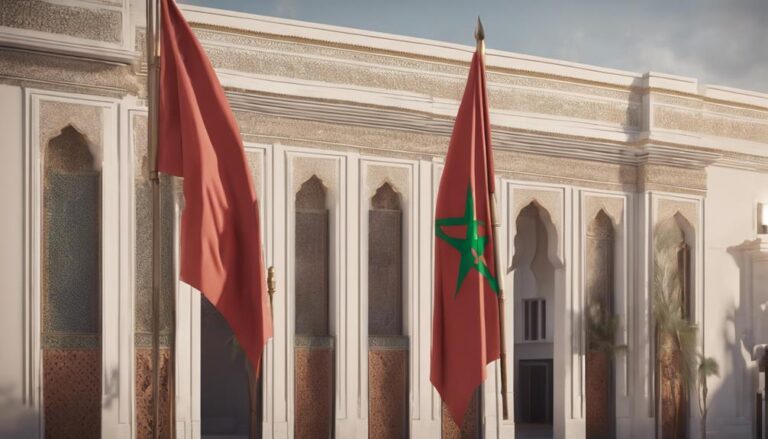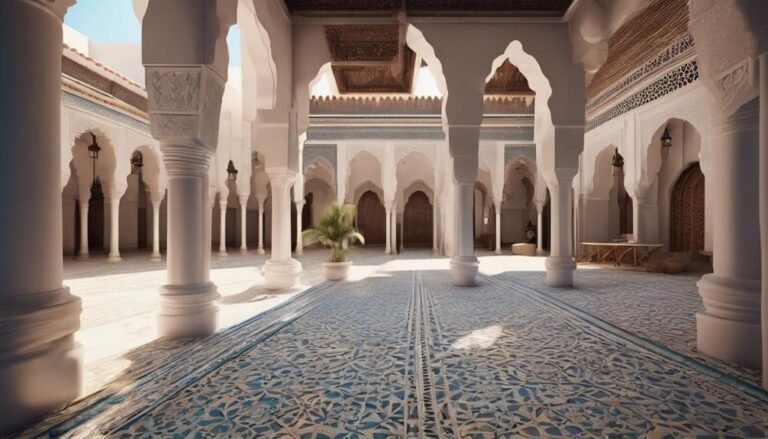The currency of Morocco is the Moroccan Dirham, a symbol of economic stability and growth. It has a rich history, initially linked to the French Franc before moving to a floating exchange rate regime in 1973. The Dirham reflects a unique blend of cultural heritage and modern financial systems, making it an integral part of Morocco’s economic landscape. Understanding its significance is essential for investors, analysts, and businesses engaged in international trade. Exploring further will reveal more about the design, security features, impact on tourism, and future trends shaping the Moroccan currency.
Key Takeaways
- Moroccan Dirham is the official currency.
- Introduced in the early 20th century.
- Symbol of economic stability and growth.
- Influenced by inflation rates and political stability.
- Widely accepted in commerce and tourism.
History of Moroccan Dirham
The history of the Moroccan Dirham dates back to the early 20th century when it was introduced as the official currency of Morocco. Since its inception, the Dirham has undergone a significant transformation in terms of its value and usage within the country. Initially, the Dirham was pegged to the French Franc, and later to a basket of currencies, before eventually shifting to a floating exchange rate regime in 1973. This change marked an important turning point in the monetary policy of Morocco, allowing the Dirham to adjust its value according to market forces.
The significance of the Dirham lies not only in its role as a medium of exchange but also as a symbol of Morocco’s economic stability and growth. Over the years, the Dirham has remained relatively stable, which has helped foster investor confidence and facilitate international trade. Additionally, the Dirham’s evolution reflects Morocco’s commitment to modernizing its financial system to align with global economic trends.
Design and Symbolism
With intricate patterns and historical motifs, the design of the Moroccan Dirham reflects a blend of cultural heritage and modern aesthetics. The Moroccan currency showcases symbolism and cultural significance through its design elements.
- Islamic Art Influence: The Moroccan Dirham’s design draws inspiration from traditional Islamic art, featuring geometric patterns and calligraphy. These intricate designs symbolize the country’s rich Islamic heritage and artistic traditions.
- Historical Figures: Some Moroccan Dirham coins and banknotes depict important historical figures, such as past rulers or significant personalities. These images serve as a reminder of the nation’s history and the contributions of key figures to Moroccan culture and society.
- Natural Motifs: The design of the Dirham also incorporates natural motifs like plants, animals, or landscapes. These symbols reflect Morocco’s diverse natural environment and add a touch of local flavor to the currency’s visual appeal.
Exchange Rate Information
Amidst fluctuating global economic conditions, the Moroccan Dirham‘s exchange rate remains a focal point for investors and analysts seeking insights into the country’s financial stability. Currency fluctuations play a significant role in determining Morocco’s economic impact on international trade and foreign investment. Understanding the exchange rate dynamics is vital for businesses engaged in import-export activities with Morocco, as it directly influences the cost of goods and services.
The exchange rate of the Moroccan Dirham is influenced by various factors such as inflation rates, interest rates, political stability, and market speculation. These elements contribute to the volatility seen in the currency markets, impacting the competitiveness of Moroccan goods in the global market. For investors, keeping track of the Dirham’s exchange rate is essential when considering foreign direct investment opportunities in Morocco.
Monitoring the exchange rate trends and analyzing the economic indicators that influence it can provide valuable insights into the country’s economic health and potential risks. By staying informed about currency fluctuations, investors can make informed decisions regarding their international business ventures in Morocco.
Security Features
Investors and analysts interested in evaluating the Moroccan Dirham’s authenticity and integrity often scrutinize its intricate security features. When it comes to the Moroccan Dirham, the following security features are essential for ensuring its credibility:
- Counterfeit prevention: The Moroccan Dirham incorporates advanced security measures to deter counterfeiting. Features such as watermarks, security threads, and intricate designs are integrated into the banknotes to make them difficult to replicate accurately.
- Unique patterns and elements: The Moroccan Dirham includes unique patterns and elements that aren’t easily reproducible. These intricate details, visible under UV light or through special tools, provide an added layer of security against counterfeit attempts.
- Innovative technologies: To adapt to the digital age and promote cashless transactions, the Moroccan Dirham continues to evolve its security features. Incorporating technologies like holograms, microprinting, and color-changing inks, the currency aims to stay ahead in the battle against fraudsters while facilitating secure electronic payments.
Usage and Acceptance
When using the currency in commerce, you may find that the Moroccan dirham is the primary form of payment accepted in the country.
It’s important to be aware of the exchange rates in Morocco, as they can fluctuate and impact the value of your transactions.
Understanding the usage and acceptance of the Moroccan dirham is vital for effectively managing the local economy.
Currency in Commerce
The Moroccan currency, the Moroccan dirham, is widely accepted in commerce across the country, facilitating smooth transactions for both locals and tourists.
- Economic Impact:
- The use of the Moroccan dirham in commercial activities greatly contributes to the stability and growth of the Moroccan economy.
- International Transactions:
- Due to its acceptance and stability, the Moroccan dirham is also utilized in international trade transactions, fostering economic relationships with other countries.
- Convenience and Efficiency:
- The widespread acceptance of the Moroccan dirham in commerce guarantees convenience and efficiency for both businesses and consumers, reducing the need for currency exchanges and simplifying financial transactions.
Exchange Rates in Morocco
The utilization and acceptance of exchange rates in Morocco play a pivotal role in facilitating international transactions and maintaining economic stability within the country. Banking services in Morocco heavily rely on accurate exchange rates to enable seamless cross-border transactions for businesses and individuals. These rates are vital for determining the value of the Moroccan Dirham against other currencies, impacting imports, exports, and overall economic performance.
Economic stability is closely monitored through exchange rate fluctuations, as they can affect inflation rates, foreign investment levels, and the overall competitiveness of Moroccan goods and services in the global market. Understanding and adapting to these exchange rate dynamics are essential for businesses, financial institutions, and policymakers to navigate the complexities of international trade and finance effectively.
Currency Exchange Tips
Take into account the current exchange rates and fees before converting your currency to guarantee you get the best value during your travels in Morocco. When dealing with foreign exchange for travel expenses, being strategic can help stretch your budget further.
Here are three currency exchange tips to take into consideration:
- Compare Exchange Rates: Research different exchange services or banks to find the most favorable rates. Sometimes, it might be more cost-effective to exchange a larger amount at once to minimize fees.
- Use ATMs Wisely: While ATMs can be convenient, they may come with high withdrawal fees or unfavorable exchange rates. Try to withdraw larger amounts less frequently to reduce these additional costs.
- Avoid Currency Exchange at Airports: Airport exchange services often have higher fees and less competitive rates. It’s advisable to exchange a small amount for immediate needs and find a better exchange service in the city for the bulk of your currency exchange.
Impact on Tourism
When assessing the impact of currency on tourism in Morocco, it’s essential to analyze how fluctuations in exchange rates can influence visitor spending patterns.
Tourism revenue can experience significant boosts or declines based on the strength or weakness of the Moroccan currency against major international currencies.
Understanding these dynamics is vital for stakeholders in the tourism industry to make informed decisions and adapt strategies to maximize economic benefits.
Tourism Revenue Boost
Experiencing a significant surge in tourism revenue, Morocco’s economy is benefiting from increased visitor spending. This boost in tourism revenue has led to several positive outcomes for the country:
- Economic Growth: The influx of tourists has stimulated economic growth by creating job opportunities in the tourism sector and related industries.
- Foreign Investment: The rise in tourism revenue has attracted foreign investors looking to capitalize on Morocco’s growing tourism industry, further bolstering the country’s economy.
- Cultural Significance: The increased tourist spending hasn’t only boosted the economy but has also highlighted the cultural significance of Morocco, promoting local artisans and traditional craftsmanship.
These factors collectively contribute to Morocco’s economic development and cultural preservation.
Currency Exchange Rates
Currency exchange rates play a significant role in influencing the flow of tourism in Morocco. Fluctuations in foreign currency values can impact the attractiveness of Morocco as a tourist destination. When the Moroccan Dirham is weaker compared to major foreign currencies like the Euro or the US Dollar, it can make traveling to Morocco more affordable for tourists from those regions, potentially leading to an increase in tourism. Conversely, a stronger Dirham may make visiting Morocco more expensive for foreign tourists, potentially decreasing the number of visitors. This economic impact highlights the importance of monitoring and understanding currency exchange rates for stakeholders in the Moroccan tourism industry.
| Factors Influencing Tourism |
|---|
| Exchange Rate Stability |
| Economic Conditions |
| Political Stability |
| Competing Destinations |
| Seasonal Trends |
Future Trends and Developments
As the global economy continues to evolve, significant shifts in currency valuations are expected to impact the Moroccan economy in the coming years.
- Digital Payments and Economic Growth: The adoption of digital payment solutions in Morocco is likely to increase as the country aims to enhance financial inclusion and drive economic growth. By leveraging digital payment methods, Morocco can streamline transactions, reduce costs, and improve overall efficiency in the financial sector.
- Blockchain Technology for Financial Inclusion: The integration of blockchain technology in Morocco’s financial infrastructure could promote greater financial inclusion by providing secure and transparent ways to access banking services. Blockchain can enable efficient cross-border transactions, reduce fraud, and enhance trust in the financial system.
- Diversification of Currency Reserves: With the changing global economic landscape, Morocco may consider diversifying its currency reserves to mitigate risks associated with fluctuations in major currencies. By diversifying holdings into stable currencies or commodities, Morocco can safeguard its reserves against potential economic uncertainties.
Conclusion
In summary, the Moroccan Dirham stands as a symbol of the country’s rich history and culture. With its unique design and security features, it reflects Morocco’s commitment to innovation and tradition.
As the currency continues to evolve and adapt to global economic trends, it plays a pivotal role in shaping the country’s economy and attracting tourists from around the world.
Just as the Dirham is a cornerstone of Morocco’s financial stability, it also serves as a gateway to experiencing the vibrant culture and beauty of the country.

The Editorial Team is a passionate group of Morocco enthusiasts dedicated to sharing the beauty, culture, and wonders of this captivating country. With diverse backgrounds and a deep love for travel, we strive to bring you engaging and informative content that inspires your Moroccan adventures. From uncovering hidden gems and sharing local insights to exploring mouthwatering cuisine and showcasing the vibrant lifestyle, our team is committed to providing you with valuable resources and exciting stories that enhance your exploration of Morocco. Join us on this journey as we celebrate the rich heritage and unforgettable experiences that make Morocco truly special.







